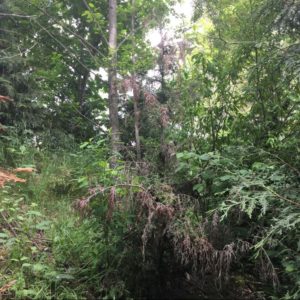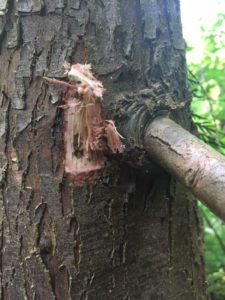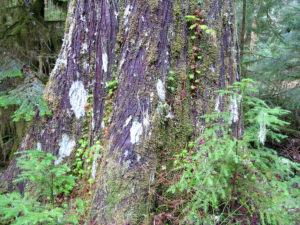In the last two-years, Seattle Parks and Recreation Urban Forestry staff have received increasing reports of dead Thuja plicata, Western redcedars, in Seattle Parks. Our arborists have also been observing more Western redcedar deaths in the last several years. I have been documenting this phenomenon and have reached out to several industry colleges for help in identifying what is the cause of this die-off. I have documented several early indicators of this Western redcedar die-off. These indicators include branch collar swelling, advantageous twig sprouting around the swollen branch collar area and individual branch die-off. In later stages the trees will die from the top of the tree downwards.
I worked with Kevin Carr and Dr. Drew Zwart from Bartlett Tree Experts, to identify several pests which are playing a role in the decline of these trees. One is wood borer named Trachykele blondeli Marseul, western cedar borer. The other is a yet to be determined bark beetle from the beetle family, Scolytidae. My determination is that these common native pests are becoming more prolific in our Western redcedars due to climate change. Recently, both Washington State University Forestry Extension and Washington Department of Resources have recently posted blog posts about mortality of our common PNW conifers due to drought stress:
- WSU North Puget Sound Extension Forestry E-Newsletter – July 2018
- WA DNR Tree Link “Emerging Issues with Western Hemlock and Douglas-fir” – 3 July 2018
Western redcedars have been a popular choice of our forest restoration volunteers for a long time. These trees are iconic to our area and loved by our local naturalists. For several years, our Urban Forestry Staff and Green Seattle Partnership staff have been observing and receiving reports of an increasing amount of dying western red cedars in our park system.
My recommendation is to limit the planting of western red cedars in our park system to lowland sites where nighttime temperatures are lowest and water is readily accessible.
Observations
In spring of 2018, I decided to start documenting dead Western redcedars to find a pattern of their decline. Once I noted a pattern, I sought help from Bartlett Tree Experts to assist me in determining why these trees are dying and what the GSP and Urban Forestry units can do preserve the health of these trees. The trees which I investigated were planted in a suitable location for Western redcedars. I did not investigate trees that were growing on slopes or were in areas that could be predisposed to experience a lack of water. I specifically looked for established trees that were growing in depressions within shady natural areas. The trees which I documented were all unexplainably declining. They were experiencing individual branch die-off at the early stages of decline. The trees all had abnormal branch collar swelling. Some trees had young branch shoots emanating from the trunk around the branch swelling.
The several older trees which I observed had large sapwood wounds around these swollen branch collar areas. There was also sporadic sap leaking on the trunks of the trees. In later stages of decline, the trees would start dying at the top of the canopy with decline progressing downward. There was some frass and insect boring holes on the trunks of the trees. I found bore galleries on the lower trunks of trees. I showed some of the pictures that I had collected to Arborist colleges, Kevin Carr and Dr. Drew Zwart. Both agreed to come and meet me to inspect several of cedars experiencing the unexplained die-off. During this investigation, we extracted an unidentified bark beetle from around a swollen branch a trunk attachment and plant pathologist, Dr. Drew Zwart found galleries from the Western cedar borer.
Discussion
According to Dr. Zwart, both pests which we found are native to our area. These pests are well known in forestry but are not knowing to be critical to cedar health on a widespread level. The Western cedar borer is known to infest the collar of branch attachment leading to swelling around the branch collar area. In it’s larval stage, the borers feed in the tree’s cambium which cuts off the trees ability to transfer water and nutrients throughout the tree. With extensive infestations, the borer galleries will essentially girdle the tree leading to rapid death. The bore will eventually exit the tree in its adult stage and fly to another stressed tree where the cycle will begin again.
Conclusion
I believe that climate change has over-exerted these trees to a point where this historically non-critical pest has killed many of our western red cedars. As our region is experiencing an increase in warmer nights, our trees are not halting their respiration process and are depleting their carbon resources. This puts the trees in a state of stress. The native Western cedar borer is taking advantage of the weakened trees and infesting them to a greater level of trees then previously noted. Our smaller diameter Western redcedars are more susceptible to this infestation as they more easily girdled by borer galleries.
Recommendations
Our only practical option for management is to look to rely less on Western redcedar as a planting option.
Western redcedar trees should not be excluded as a forest restoration choice but should be more appropriately planted. They should not be planted in the open or in lawn areas. Trees should be limited to lowland areas where the night time temperatures are coolest. They should only be planted in shady areas were water is readily available.
—
P.S. I am seeing a rise in the amount and severity of a wood decay organism called Perennidporia subacida or Stringy butt rot. Below is a photo of this organism to help with identification. I would note that to identify it, one would look for a white organism pressed up against the tree in between fissures in the trunks bark. This organism would be all white when immature and would have a brown center with white outline once it becomes mature. This is a slow-moving organism, which only grows a centimeter a year, but it can cause tree failure, die-back or death over a long period of time.
Glossary
Branch collar: The often-visible swelling in a woody plant that forms at the base of a branch where it is attached to its parent branch or to the tree’s trunk
Sapwood: Outer wood (xylem) that is an active longitudinal transport of water and minerals
Frass: Fine powdery refuse or fragile perforated wood produced by the activity of boring insects
Galleries: Tunnels created by feeding insects. Often filled with their frass.
Cambium: Thin layer(s) of meristematic cells that give rise (outward) to the phloem and (inward) to the xylem, increasing stem and root diameter
Respiration: A chemical reaction by which plant cells stay alive. Through respiration, plants use oxygen and produce carbon dioxide. The result is the release of stored energy for use.
Contact
Chris Rippey | Seattle Parks Urban Forestry | ASCA RCA #633 | Certified Arborist/Municipal Specialist (WE-7672AUTM) | Tree Risk Assessor Qualified | Christopher.Rippey@seattle.gov






Glad to have found your website. I live in the Birch Bay area of NW Washington. I have several dead or dying Western Red Cedars on my property and my neighbors properties. The pattern of decline is as you described. The dying off of the Cedars begins at the top and continues downward. I first considered drought as a likely cause, but these trees are not located on slopes or other areas where drought might be considered an obvious cause. Odd thing is that there are healthy Cedars in the immediate areas of where the dying Cedars are located. Happy to send specific location and photos if needed or wanted. I’m guessing that the only real solution is to pay to have the dead and dying trees removed. Not sure if there would be any salvage value to the lumber from the trees. Between my trees and my neighbors’ trees, there are probably at least 8 dead or dying trees, some of marketable timber size.
Thank you. I came across this piece because I have been witnessing thuja plicata die off in the forests around where I work and live in the skykomish valley. It is concerning to see trees even in wet low-lying areas are dying in addition to the upland trees that blanket our hillsides. Our Tsuga heterophylla and Alnus rubra are also stressed and dying. 🙁
Chris,
Thank you for this! My wife and I have noticed many sick cedar trees, and this was the first presentation that popped up online. We are very concerned. For anyone concerned about mass conifer die off, EMPIRE OF THE BARK BEETLE by Andrew Nikiforuk is very illuminating.
Thanks for blog. We have a western red cedar surrounded by Douglas Fir, Ponderosa Fir, short needled fir and a pine. Found that the Western Red Cedar dying on top west/sunny side. Whole tree looks sick. No sign of beetles. Ate you saying it might just not be getting enough water? Beaverton OR
Sounds to me like its the increased overall temperatures, night time temps included. But lack of water too.
Western redcedar are not very drought tolerant, so if a tree is in an area pre disposed to being dry, like a rocky hillside ect it can get stressed by relatively small droughts making it an easy target for infestation.
Have you found these same borers in healthy specimens ? From your research, do they seem to be arising as primary or secondary pests ?
Have you had a chance to do any experiments with longer term attempts at reversing this weakness and attack by borers? You mentioned the pesticidal approach had success.
We’re seeing very much the same pattern in BC, widespread flagging and deaths in otherwise successful, semi-mature to mature western red cédera.
Great article Chris… I manage 3000 acres of forest land in Anacortes, WA and have observed 1000’s of western red cedar trees die this year along with 100’s of western hemlocks last year. I believe they are very drought stressed as we have had 4 summers of drought and warm weather here in Anacortes. I am also a Certified Arborist, so it has been very concerning. I am also observing plenty of trees dying in homeowners yards this year. It will be interesting to see how our forests adjust.
I live in south Snohomish county in the Town of Woodway, which is heavily forested with the usual assortment of local trees, and we have an extremely strict tree removal code. On my three acres alone, plus my neighbors surrounding 8-10 acres, I have witnessed the rapid decline and death of hemlock as described in your article. I first noticed it in summer of 2016 when the woods were literally filled with flickers and woodpeckers tapping all day on the tree trunks. I only wish I could afford to have these dead trees removed but it is very expensive.
Recent walk through wooded areas of Robinswood Park in Bellevue has driven home this phenomenon of Western Red Cedar die off as every cedar tree in the park is dead or dying: young and older. Just heartbreaking as relatively sudden, although began noticing last year in younger trees. Now even well established ones in cooler wetter locations are dying from top down.
Wondering, if besides climate warming, if the general loss of vegetation biomass due to rapid urban/suburban development is creating a kind of exposure & warming which weakens cedars and hemlocks to the extent that they perish.
Excellent article.
However, draught and climate change are two completely different phenomenon. Washington State average temperature has increased by about one half degree in the past 30 years per a science study completed in 2018. If that is incorrect, someone please post a link to another conclusion/study.
Washington State has definitely had long periods without rain, but facts are pretty stubborn … temperature is increasing, but at a barely perceptible annual rate.
“I believe that climate change has over-exerted these trees to a point where this historically non-critical pest has killed many of our western red cedars” should possibly be changed to drought.
One might argue climate change is causing summer droughts, but I’m in the camp that something has to be observed for roughly a decade to establish a climate trend. It’s hard to argue the Texas/Oklahoma droughts and eventual dust bowl in the 30’s was caused by climate change.
Thanks for an informative article. I have severe cedar die-back at my place in Olympia. And now I know what that strange looking termite sort of thing is, the cedar wood borer larvae….I found it in my water feature…I wonder how it got there? It was definitely what was pictured. It is so discouraging watching so many of my trees die off. I have worked with a few arborists, and had to have a number of trees removed, but it seems this is the way things are going. Thanks again for the good article.
My cedars, my neighbors cedars, and cedars 25+ miles from my house are all dying or dead.
Thanks for the article. I have lost 3 -36”+dbh western red cedars, plus several smaller ones. We are in Portland in a shady forested hollow with high ground water, but even here the last couple years of drought the trees are dying. All around us they are dying as well. It’s heartbreaking and very expensive.
I have two very old red cedar trees on my property that started looking ill two years ago. They were nice healthy 80’+ trees and now most of the top half are withered and dead. I’m probably going to have to have them removed in the next year. It’s really sad because I know the trees are very old, I loved those trees. Not to mention it’s also going to cost a lot to take them down. I’m hoping a logging company might do it since I live in a logging town…they can keep the wood.
I live in Beaverton Oregon. 2 large WRC trees have died in been removed this past year. They died of Borer infestation derived from trees in my neighbors yard. Today the remaining 5 WRC trees in my yard were treated with drenched systemic pesticide for prevention. The product was applied by a Tree care company in Kaiser, Oregon. The treatment is not inexpensive. Time will tell if the treatment works. Stay tuned.
We live at an elevation of about eight hundred feet, in the Cascade foothills. we live on wooded acreage, in an area is described as a Hemlock rain forest, which is in very close proximity to the Seattle, Cedar River, water shed. We’ve been monitoring the rainfall on the property for the last several years, which we have determined to be 70″+/yr. The total yearly rainfall seems consistent year to year, but the pattern of heavy winter storms, and extended dry periods of hot, dry, weather, in the summer, has been an observable change.
Within the last year and a half I have noticed a problem with two of our established trees, in close proximity to the house. One is a cedar, the other a hemlock, both are 70+ feet tall with a girth of 18-20 feet. Last summer I discovered weeping bore holes in the trunk of both. This winter the bark of the cedar has began to peel off. I suspect that each suffers from a different blight. The process is very troubling, since the area in which we live is truly a rain forest. If this area is affected, I fear for the long term prognosis for all of the west slope of the Cascades.
Thank you for your insightful article and to all who have shared their similar experienced.
Eastern Sierra @ 5200’, transition zone between Sierra and basin & range. I have watched WRC’s dieing Here from the top down for the last 40 years. They die on every aspect, creek side or on South facing dry slopes. Keep me posted on further info. Thanks
I am a resident in Snohomish county and to my horror I just discovered that 4 cedar trees in my property are dying.
Could you, please, direct me as far as who can I contact to advise me and, if possible, visit my property and tell me what to do.
A million thanks, Sincerely, Tina
Thanks for the informative article. I live in British Columbia, and my Western Red Cedar I have in my yard, about 15 years old, got hit with the exact same situation. The past few years every autumn there was significant leaf dieoff, and this summer the worst came to pass: of the 3 trunks that grew out of this tree the tallest and sturdiest trunk began to wilt from the top down. Today when I watered it I decided to feel the leaves on the top half, and they were completely dried, no hope of saving that half. It’s very sad to see the tree, which grew in my yard from a sapling from a seed that drifted into the yard ~15 years ago, be in such a state it is now. That tree had great sentimental value with me, I watched it grow up, and now it’s dying far sooner that it would normally.
We have been experiencing a mass cedar die off on and around our property as well. About 15-20 on our property alone. We live on a low river bank and about 4 of these large very mature cedar trees are along the rivers bank, but are still all dying from the top down. Due to our observations, a drought can be discarded from the cause here due to year round water in the cedar river feeding these trees. There are also only a few homes above us on this river before it is protected water shed, so human water pollution can be discarded as well.